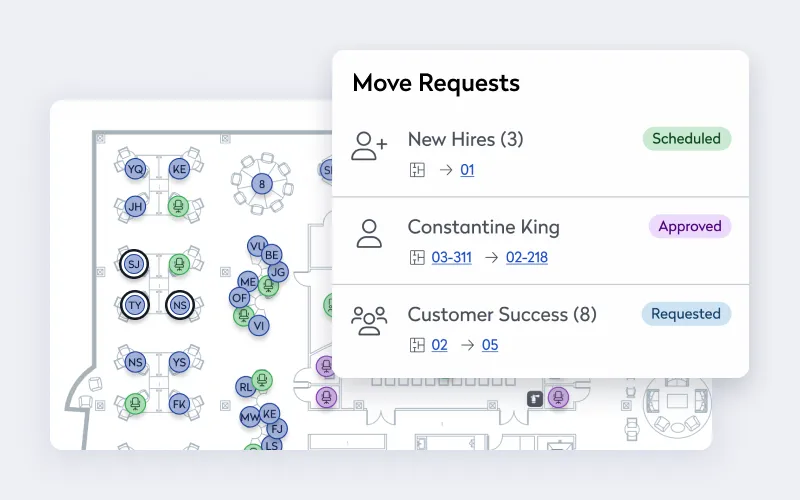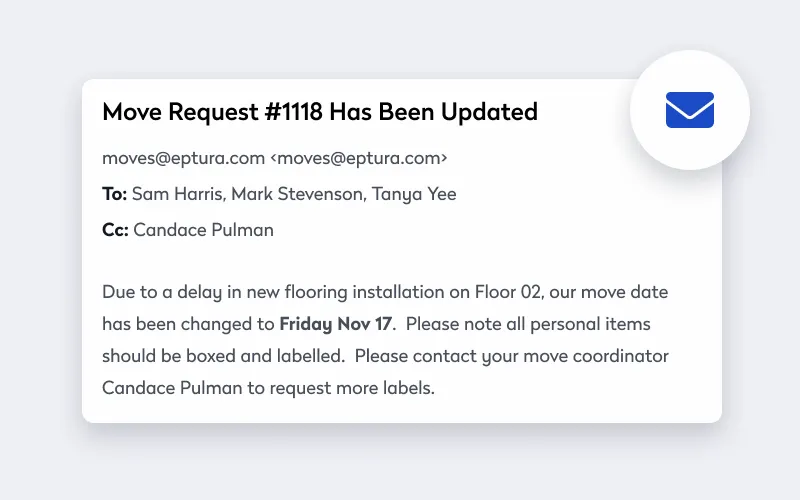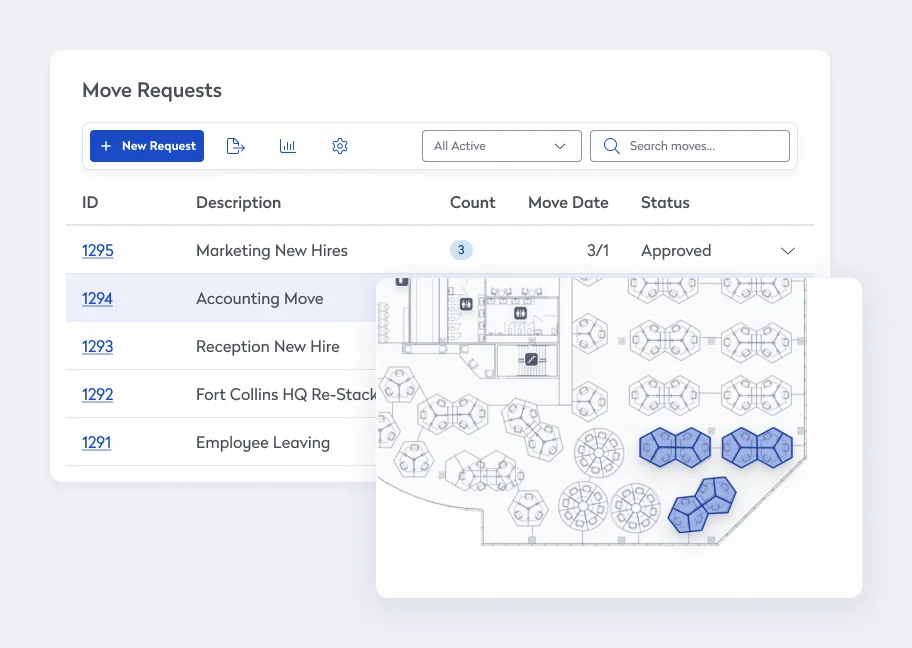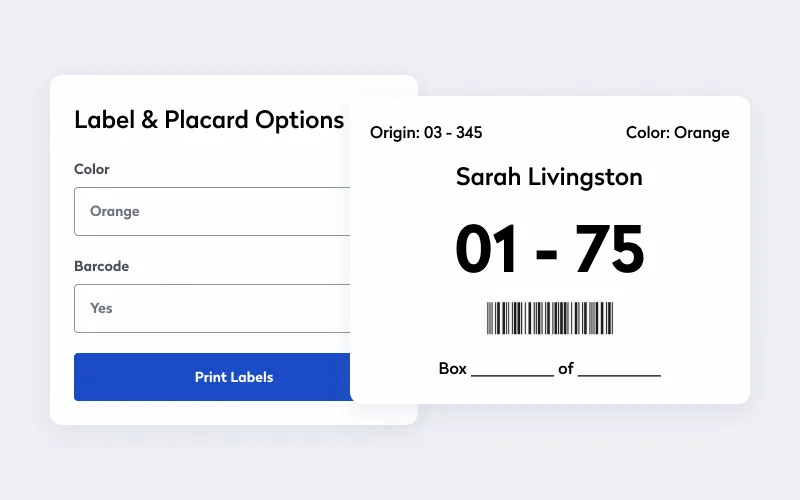
Strategic moves help governments boost employee productivity and optimize space utilization, better positioning employees, reducing unnecessary overhead, and aligning the physical workspace with the agency’s mission and goals. But because there are so many moving parts, these projects can quickly become frustrating and costly. Modern move management software empowers leaders at all levels to deliver efficient moves while controlling costs and avoiding disruptions.
What is move management for government agencies?
Move management is the process of planning, organizing, and executing the relocation of employees, equipment, and assets.
It covers a variety of move types, including:
- Interoffice: Relocating employees or equipment within the same building
- Whole department: Moving an entire department to a new location
- Single employee: Relocating a single employee, often due to a promotion or new role
- Team: Moving a specific team or group of employees to a new location
- Office relocations: Moving the entire office to a new building or city
- Consolidations: Combining multiple offices or departments into a single space
- Expansions: Moving to a larger space to accommodate growth
- Rightsizings: Moving to a smaller space to reduce costs or streamline operations
- International: Relocating employees to a different country or region
- Temporary: Short-term relocations, often for specific projects or assignments
Regardless of the size of the move, proactive move management ensures minimal disruption, maximum cost efficiency, and a smooth transition for all involved.
When does moving make the most sense for government employees, offices, departments, and agencies?
There are many benefits to moving single employees, both within their current facility and to new ones. By placing employees where their skills are most needed, the agency can maximize the value they bring to the organization, leading to more efficient problem-solving and better project execution. And for employees, a move can provide valuable professional development opportunities. Exposure to new environments and challenges can enhance their skills and career prospects.
By moving smaller teams, agencies can create more flexibility and efficiency in resource allocation. Strategic move management helps leadership put the right people in the right places at the right times.
Relocating a larger team to a new location can allow for major renovations, while moving into a newly constructed or renovated building helps an agency better meet its needs. Other times, organizational changes, such as reorganizations or leadership directives, necessitate a move. For example, merging departments or creating new teams might require a new layout or location that better supports the changes.
Moves of all sizes can also help governments meet many of their most important organizational goals.
Fiscal responsibility
Moves can mean significant savings and improved efficiency. By rightsizing and consolidating offices, government agencies can reduce lease payments, utilities, and maintenance costs, leading to substantial financial savings.
Consolidation also allows for more efficient resource allocation, ensuring government resources are used more effectively. Streamlining operations in a more centralized location can simplify administrative processes and reduce bureaucratic overhead, making the government more agile and responsive.
And bringing different departments together in one space can enhance interdepartmental communication and collaboration, leading to more effective decision-making and a more cohesive work environment. In fact, improved collaboration often brings better service delivery. A single, larger office provides a more convenient and accessible location for citizens to access services. Centralized locations can also improve accessibility for a wider range of citizens, including those with disabilities, ensuring that government services are more inclusive and equitable.
More connection and collaboration
Moving to a more strategic location can improve access to key stakeholders, such as other government agencies, partners, and the public. Proximity can facilitate better communication and collaboration, leading to more effective and coordinated efforts. A central location can also enhance the visibility and accessibility of government services, making it easier for citizens to engage with the government and access the support they need. This strategic positioning can help the government better serve its constituents and build stronger relationships with key stakeholders in the industries they regulate and serve.
What are the common challenges in government facility transitions?
The first challenge when considering a move is establishing necessity, and leadership needs to look at a variety of metrics and key performance indicators (KPIs) before deciding.
For example, a move might make sense when a review of existing spaces reveals excess square footage, low utilization rates, uneven density numbers, poor circulation and flow, and a lack of flexibility and adaptability. There might also be issues with current amenities and the costs connected to required upgrades and retrofits that make moving the best option.
Here, a modern intelligent worktech and facility management platform is indispensable for the ongoing capture of reliable data. When any organization, public or private, must make critical choices, they need data they can trust.
Once the organization has decided to make a move, there are several challenges organizations face, including:
- Logistical coordination: Coordinating the movement of furniture, equipment, and supplies can be logistically complex
- Budget management: Moving and consolidating spaces can be expensive, and costs can easily spiral out of control
- Operational continuity: Ensuring that the move causes minimal disruption to business operations is crucial
- Vendor management: Coordinating with multiple vendors for moving, cleaning, and other services can be complex
But with proper planning supported by the right platform, organizations of any size can successfully manage even the most complex moves.
What are step-by-step strategies for move management?
Moving management, whether it’s for a single employee, a small team, or an entire department, can be a complex process. But with the right planning and platform, it can also be a smooth and efficient transition.
1. Start the project
Assemble key stakeholders, including representatives from facilities, information technology (IT), human resources (HR), and department heads, to ensure a comprehensive approach to the move. The team will be responsible for overseeing the entire process and addressing any issues as they arise.
Next, clearly define the goals and objectives, which can include achieving cost savings, improving space utilization, and enhancing collaboration among teams. Once the team sets the objectives, develop a detailed project plan that outlines timelines, milestones, and specific responsibilities for each team member. The plan serves as a roadmap to ensure the move is executed smoothly and efficiently.
2. Conduct a needs assessment
Start by determining the space requirements, making sure to include everyone from individual employees to entire departments. Here, it’s important to understand specific needs to ensure everyone has the necessary room to work effectively.
Next, assess the technological needs, including network infrastructure, hardware, and software. In a successful move, it’s crucial to maintain productivity and ensure all systems are up and running in the new location. Finally, ensure the new space meets all regulatory requirements like wheelchair accessibility compliance and data security standards.
3. Plan the new space
Implement and leverage move management software to create and modify floor plans to ensure the layout is efficient and meets needs. Modern platforms facilitate the visualization and adjustment of the space to optimize workflow and collaboration.
Once the team has finalized the floor plans, assign seating and workstations. Consider factors like team dynamics and workflow to create a harmonious and productive environment. Make sure to include spaces that support employees on the hybrid work model. Set up bookable desks and meeting rooms.
Determine what furniture and equipment will be moved, replaced, or upgraded. Create a process for systematically assessing the condition and functionality of existing items and deciding whether they are suitable for the new location.
4. Set the budget and create cost controls
To ensure financial control and transparency, start by developing a detailed budget that includes all anticipated costs. A comprehensive budget should cover expenses such as moving services, new furniture, technology upgrades, and any necessary renovations. Once the budget is in place, use the move management software to track expenses. Monitor spending closely to ensure the project stays within the allocated budget.
5. Choose vendors
For larger moves, select reliable vendors for moving services, IT support, and other necessary needs. Once the contracts are in place, coordinate with the vendors to ensure they are fully aware of the move schedule and specific requirements.
For example, a federal agency might select a reputable moving company and IT support vendor, negotiate detailed contracts that outline specific services and timelines, and then coordinate with these vendors to ensure they are aligned with the move schedule and any special requirements, such as handling sensitive documents or setting up secure network infrastructure.
6. Communicate with stakeholders
Keep all stakeholders informed through regular updates, meetings, and newsletters. Regular updates can be particularly important for large organizations, such as federal agencies, where multiple departments and teams are involved.
In addition to stakeholder communication, provide training on the new space, technology, and any changes in procedures. Training ensures that employees are familiar with their new environment and can quickly adapt to any new systems or processes. For example, a city government office might offer training sessions on the layout of the new building, the use of new technology, and any updated safety protocols.
Across industries, communication is quickly becoming a critical skill for facility and workplace leaders. In fact, in Eptura’s webinar “The future of facility and change management,” guest Marc Weigum, senior director of Cumming Group and Founder of Unified Purpose, recommends facility managers focus on interpersonal communication and prepare to be more visible in their roles.
“Being prepared to be more front and center and how do you show up and how do you communicate and how do you articulate what you want to do in a way that other people are going to understand, not just your facilities group, because they all talk the same language. You have to kind of be able to, you know, get out your translator app and make sure they understand.”
7. Plan all the logistics
Create a detailed move schedule that includes the order of moves and any necessary downtime. The schedule should outline the specific dates and times for each phase of the relocation, helping to minimize disruptions and keep everyone on track.
Also develop a plan for packing and unpacking that ensures sensitive documents and equipment are handled securely, with clear guidelines on how to pack and label items, as well as who is responsible for each task. For example, a government healthcare facility might have a detailed protocol for packing medical records and sensitive equipment to ensure they are protected and easily identifiable.
What are the important features of effective move management software?
At every step, modern move management software delivers several powerful features to enhance the efficiency and accuracy of workplace relocations.
Intelligent algorithms for streamlined movements: Optimize the movement of employees and groups, reducing the time and effort required for planning and execution.
Use case: A federal agency is relocating multiple departments to a new building. Managers can leverage the software’s intelligent algorithms to efficiently plan the movement of each department, ensuring minimal disruption to daily operations.
Drag-and-drop floorplan adjustments: Easily and intuitively modify floor plans, making it simple to visualize and adjust the layout.
Use case: A state government office is redesigning its space to accommodate a growing team, and the drag-and-drop feature enables the space planning team to quickly experiment with different layouts to find the most efficient arrangement.
Centralized move requests and approval workflows: Minimize disruptions and make sure all moves are approved and executed smoothly.
Use case: A city government is consolidating its facilities, and the centralized move requests and approval workflows ensure stakeholders can efficiently approve all moves, reducing the risk of delays and errors.
Bulk and multi-phased moves: Manage large-scale and phased moves, ensuring that each phase is executed smoothly and on schedule.
Use case: A city government is expanding its municipal buildings and needs to move multiple departments in phases over several months. The software helps managers coordinate each phase, ensuring teams can complete the moves without overlap or conflict.
Centralized request queue and calendar view: Keep all move requests organized and visible, making it easier to manage and track progress.
Use case: A county health department is relocating its offices, and the centralized request queue and calendar view help the facility team manage and prioritize multiple move requests, ensuring the department managers can complete the moves on time.
Service tickets for operations teams: Generate service tickets for operations teams, ensuring all necessary tasks are assigned and completed.
Use case: When a state capitol’s administration is moving to a new building, the software empowers them to generate service tickets for tasks like setting up network infrastructure and installing new furniture, ensuring every team can handle their parts of the larger project efficiently.
Box label generation: Automate box label generation for organizing and tracking items during the move, reducing the risk of lost or misplaced items.
Use case: A federal court is moving to a new location, and support staff can use the platform to generate box labels for all documents and office supplies, making it easier to unpack and organize items in the new office.
Automated move notifications: Automate notifications to keep all stakeholders informed about move schedules and changes, reducing confusion and keeping everyone on the same page.
Use case: A local government office is relocating its departments, so leadership can set up automated notifications for all employees and departments, keeping everyone informed about the move schedule and any updates.
Space management integration tools: Ensure real-time updates and prevent errors, enhancing the management of space utilization and allocation.
Use case: A state department of transportation is expanding and needs to manage multiple office relocations. Integration with space management tools helps planners create real-time updates of space utilization, ensuring that each office is set up efficiently.
Robust reports and dashboards: Deliver data aggregation and insights, helping with improved planning and execution of future projects.
Use case: A government agency is conducting a major office relocation, and the reports and dashboards provide project leaders with an accurate big picture of the move’s progress and costs, helping the management team to make informed decisions for future relocations.
Benefits of effective move management
Effective move management offers numerous benefits for government agencies, particularly in terms of efficiency and rightsizing. By streamlining the move process, agencies can minimize disruptions and ensure that employees quickly resume their work in the new location.
Learn more about modern move management.








